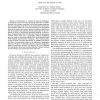Free Online Productivity Tools
i2Speak
i2Symbol
i2OCR
iTex2Img
iWeb2Print
iWeb2Shot
i2Type
iPdf2Split
iPdf2Merge
i2Bopomofo
i2Arabic
i2Style
i2Image
i2PDF
iLatex2Rtf
Sci2ools
INFOCOM
2005
IEEE
2005
IEEE
Localization for anisotropic sensor networks
— In this paper, we consider the issue of localization in anisotropic sensor networks. Anisotropic networks are differentiated from isotropic networks in that they possess properties that vary according to the direction of measurement. Anisotropic characteristics result from various factors such as the geographic shape of the region (non-convex region), the different node densities, the irregular radio patterns, and the anisotropic terrain conditions. In order to characterize anisotropic features, we devise a linear mapping method that transforms proximity measurements between sensor nodes into a geographic distance embedding space by using the truncated singular value decomposition-based (TSVD-based) pseudo-inverse technique. This transformation retains as much topological information as possible and reduces the effect of measurement noises on the estimates of geographic distances. We show via simulation that the proposed localization method outperforms DV-hop, DV-distance [3], and ...
| Added | 25 Jun 2010 |
| Updated | 25 Jun 2010 |
| Type | Conference |
| Year | 2005 |
| Where | INFOCOM |
| Authors | Hyuk Lim, Jennifer C. Hou |
Comments (0)

